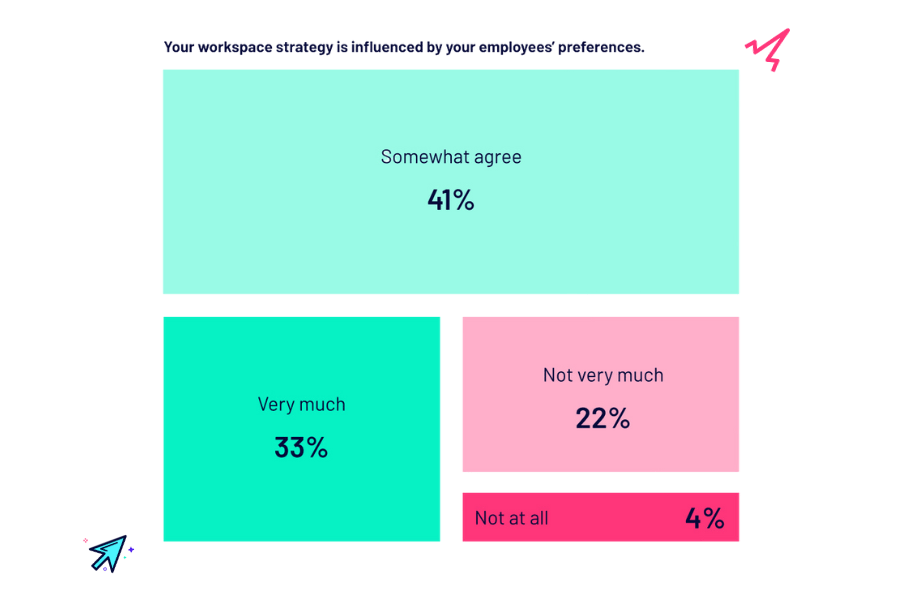It’s no secret that businesses have to navigate change. Whether it’s the unpredictable economy or a shift in workspace strategy, change is an inevitable part of business — and companies will need to adapt quickly to succeed.
For many businesses, taking employees’ considerations into account is crucial. In fact, our Workspace Satisfaction Report found that most UK business leaders take employee feedback on board when making strategic decisions.

What’s more, when asked whether their workspace strategy is influenced by employees, 41% of companies said they “somewhat agree”. This was followed by 33% who said their strategies are “very much” influenced by their team.
So, it’s clear it’s a standard practice.
But what are the pros and cons of considering employees’ preferences? And how can businesses ensure they’re surveying their teams in a way that maximises the benefits? Hubble reveals all in this quick fire article.

Finding the right office for your team can be a real challenge, but you don’t have to do it alone.
What are the pros and cons of considering employees’ preferences?
As is the case when considering any new strategy, it’s important to identify the pros and cons to see if it’s worthwhile. Here are some key things to consider when taking employees’ preferences into account:
| Pros | Cons |
| Improves engagement Listening to employees’ preferences helps them feel a greater sense of inclusivity. Their opinions are clearly valued, boosting employee satisfaction, engagement and commitment to their roles. | Hard to please everyone It’s likely your employees will have diverse preferences, so it’s hard to create a one-size-fits-all solution. This diversity can complicate efforts to establish a workspace strategy that meets everyone’s unique needs and preferences. |
| Increases utilisation of space By understanding how employees want to use workspace, you’re able to optimise it. This efficient use of space can lead to cost savings by keeping employees happy and avoiding unnecessary office space, like empty desks. | More expectations to manage Taking employees’ expectations into account can be difficult to manage. If you’re unable to meet their expectations and implement changes, it could lead to disappointment, frustration and decreased morale. |
| Boosts productivity A workspace strategy aligned with employees’ preferences promotes well-being, reduces stress, and encourages a healthy work-life balance. Employees get to work in a way that suits them, helping to boost productivity. | More resources needed Implementing changes based on employee preferences may require additional resources, both in terms of time and budget. For example, if your team wants a full-time office, the person tasked with finding one may struggle. This could make it a lengthy process, potentially disappointing employees. |
What are some best practices for surveying teams?
To paint a clear picture of your teams’ workspace preferences, sending out a survey is the way to go. Unlike discussing team preferences through 1:1s, a survey ensures everyone’s answers are recorded in writing, and there’s complete consistency in the questions being asked.
That being said, here are some best practices for surveying teams:
Define your objectives
Clearly outline the survey’s goals and what you want to find out.
Let’s say you’re considering ditching the office to save money. Make sure the questions focus on that.
For example, you could ask how often teams plan on coming into the office if you were to keep it. If the majority say 2-3 days per week, it might make sense to opt for a part-time office.
Alternatively, you could be weighing up whether to go fully remote and let teams work from anywhere, anytime.
The key is to ensure your objectives align with your current workspace setup (office-first, hybrid or remote) and what you want to achieve in the future.
Keep it short and sweet
It’s no surprise that the length of the survey can impact response rates. To boost your chances of having employees engage with the survey, it’s best to keep it short and sweet.
Design the survey so that it takes around 10 minutes to complete. This way, employees will spend just the right amount of time considering each question, providing thoughtful answers and yielding more reliable data.
Get different options
If you’re thinking about switching workspace strategies, it’s crucial that you have options. You’re not always going to please everyone, so ensuring team members give more than one workspace preference goes a long way.
For example, the could be asking people to submit more than one preferred location for a new office. You may find that everyone is happy with a certain location, even if it’s not their first choice.
This will help boost employee satisfaction and make them feel their opinions have been heard.
Utilise pre-existing data points
It’s a good idea to utilise any pre-existing data points you have as a frame of reference. This will allow you to establish a baseline for understanding past preferences, helping you identify notable trends or patterns.
What’s more, comparing current responses to previous data can also highlight shifts in employees’ priorities and needs.
Here, you could utilise data points about your team’s current office or on-demand workspace usage. For example, discover how many days the average team member uses the space(s), and who doesn’t use it at all.
This will help provide valuable insights into what workspace strategies align most with your business, informing stronger decision-making.
Cross-reference the data
Once you’ve gathered pre-existing data points, be sure to cross-check this with what your team have said about their future workspace plans. From here, you can create an estimate between the two — helping you bridge the gap between historical data and current aspirations.
Take everything with a pinch of salt
While employee surveys effectively gather accurate data, you should still take everything with a pinch of salt.
This is because it’s common for employees to overestimate how often they’ll use a workspace. People will always vote one way and then act slightly differently when it gets round to it.
For us at Hubble, a good rule of thumb is to expect 25 to 50% less usage than what the survey results suggest. This way, you can reduce your chances of paying for unused desks and boost team satisfaction.

As a flexible workspace platform, we know a lot about workspace strategy. Not only do we help businesses of all sizes give their teams great places to work, but we also practice what we preach and consider our employees’ preferences when making a significant change.
We recently did this when we switched up our workspace strategy. 👇

After running our own employee survey, we decided to move to a part-time office — helping us save a whopping £129k a year! To get the full lowdown on how we did this, check out the video above, where Tushar Agarwal, CEO and Co-Founder at Hubble, walks you through the process.
Keen to crack on yourself? To help you implement a workspace strategy that works for your business, we’ve created a checklist. In it, we provide top tips, best practices for surveying your team, and key questions to maximise its effectiveness. Download your free copy today!
